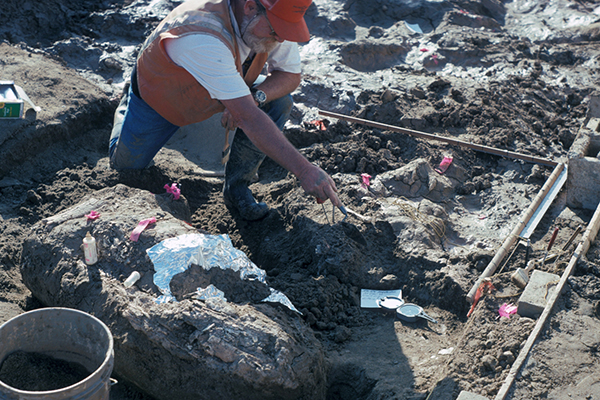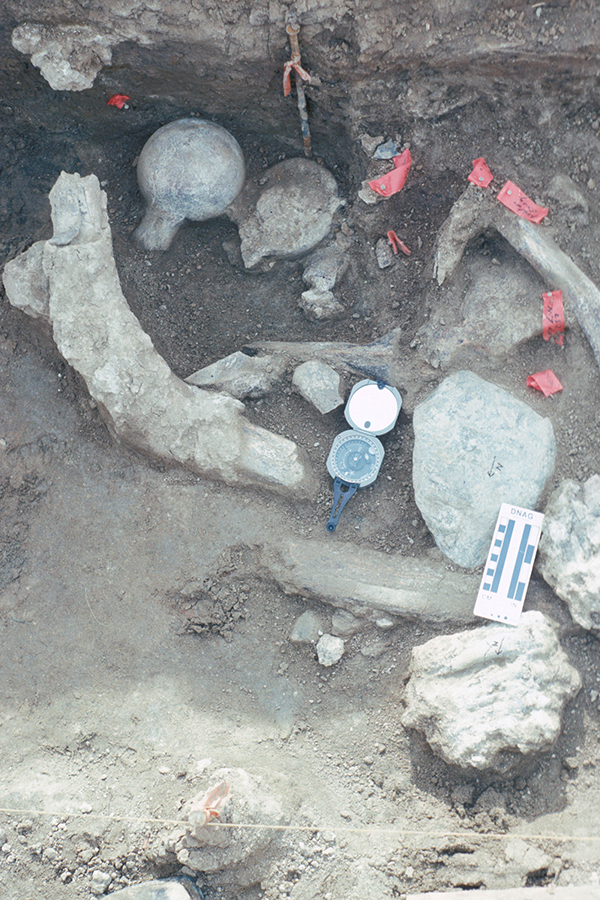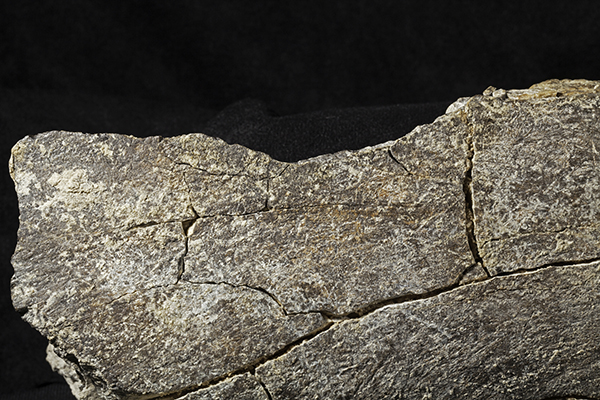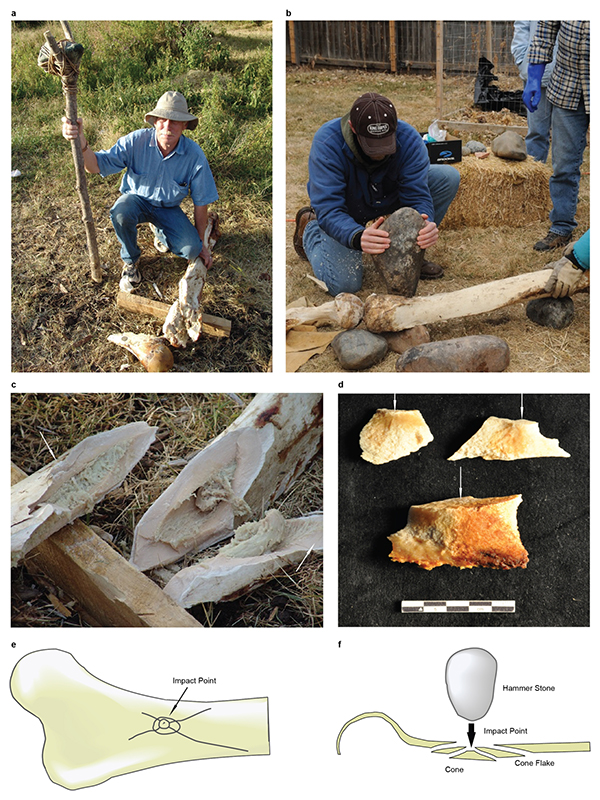
by Mary Caperton Morton Wednesday, April 26, 2017

San Diego Natural History Museum Paleontologist Don Swanson pointing at rock fragment near a large horizontal mastodon tusk fragment. Credit: San Diego Natural History Museum
In 1992, paleontologists from the San Diego Natural History Museum discovered a set of fossil bones, tusks and teeth from a single mastodon next to state highway 54 south of San Diego. Archaeologists were soon called to investigate the site, which also featured several large cobblestones — unique in the otherwise sandy matrix surrounding the bones — that seemed to have been used to break open the mastodon’s long bones, hinting at human activity soon after the animal’s death. A reliable age for the intriguing find has eluded scientists for more than two decades, but in a study released today in Nature, researchers who successfully dated the bones have come to a sensational conclusion: The site appears to date back roughly 130,000 years, more than 100,000 years before humans are thought to have lived in North America.
“The association of extinct Pleistocene megafauna and humans is exciting in and of itself, but it’s really the 130,000-year-old age of the site that is the most extraordinary result,” said Tom Deméré, a paleontologist at the San Diego Natural History Museum and a co-author of the new study, in a press conference on Tuesday. If he and his colleagues are correct, the site, called the Cerutti Mastodon site, is older by a factor of ten than the oldest widely accepted archaeological sites in the Americas, which date to between 13,000 and 16,000 years ago. (Possible indications of an earlier human presence have been noted at other sites, such as at Bluefish Caves in the Yukon, which may date back to 24,000 years ago.) “Extraordinary claims require extraordinary evidence, and we feel that the Cerutti Mastodon site offers such evidence,” Deméré said.

Fossil bones, including femur heads, a vertebra, a rib and molars, found at the Cerutti Mastodon site. Credit: San Diego Natural History Museum
In the study, Deméré and his colleagues note several lines of evidence to demonstrate that the mastodon bones represent not just a paleontological find, but an archaeological one too. Intentionally broken long bones sat alongside intact fragile bones like ribs, indicating the remains weren’t trampled, and the bones were grouped with several large rocks showing flakes and other signs of having been used as hammers and anvils.
“The bones and several teeth show clear signs of having been deliberately broken by humans with manual dexterity and experiential knowledge,” said Steve Holen, director of the Center for American Paleolithic Research in Hot Springs, S.D., and lead author of the study, in a statement. “This breakage pattern has also been observed at [14,000-year-old] mammoth fossil sites in Kansas and Nebraska, where alternative explanations such as geological forces or gnawing by carnivores have been ruled out.”
The collection of stone tool evidence at the site is very rare in that the tools, fragments that broke off the tools during use, and the bone pieces that were being smashed are all present, said co-author Richard Fullagar, an archaeologist at the University of Wollongong in Australia, during the press conference. “We have identified particular hammers that were smashed on particular anvils, and fragments from the hammers and anvils that can be refitted to the stones, alongside the broken bones themselves,” Fullagar said. “The evidence here is truly remarkable and clearly points to human activity.”
The spiral fracture patterns on the bones are consistent with the use of stone tools to break bones of a recently deceased animal, as opposed to those of a long-dead carcass, Holen said. “We think these people were seeking big thick pieces of limb bones for making bone tools. They may have also been extracting the nutritious marrow to eat.” The team noted during the press conference that although the mastodon bones were found at the site of a highway expansion project, the breakage patterns are not consistent with impacts from heavy machinery. The roughly 3 meters of fine-grained deposits above where the artifacts were unearthed also did not appear to have been disturbed since its deposition, Holen said.

The surface of mastodon bone showing half impact notch on a segment of femur. Credit: Tom Deméré, San Diego Natural History Museum
But while the broken bones and stone tools at Cerutti seem to point to human involvement, the age of the site has been uncertain. After the site was first discovered, attempts to date the bones using radiocarbon analysis failed due to the lack of preserved collagen. More recently, optical luminescence dating proved inconclusive, indicating that the bones were older than the technique’s 70,000-year maximum age. In the new study, uranium-thorium radiometric dating analyses of more than 100 samples of bone, ivory and tooth enamel revealed that the bones are about 130,000 years old, plus or minus 9,000 years.

Caption: Scientists carried out bone breakage experiments on a modern elephant's leg bones to determine the kinds of breakage patterns that result from hammerstone percussion. Credit: Kate Johnson, San Diego Natural History Museum
“We believe this is a robust, defensible age that is indeed more than 100,000 years older than what we had imagined was possible [for North America],” said co-author James Paces of the U.S. Geological Survey in Lakewood, Colo., in the press conference. Nonetheless, the team members expect the new results to spark controversy. “We invite other scholars and skeptics to go out and look in geological deposits over 100,000 years old and see if they find any evidence of human activity,” Paces said. Because scientists have thought they’ve known about “when humans came into North America, we haven’t looked in older geological deposits. It’s time to test those assumptions.”
“This is a very provocative paper,” says Michael Waters, director of the Center for the Study of the First Americans at Texas A&M University, who was not involved in the new study. “I have no issues with the geological information and the likely age of the locality,” Waters told EARTH. But he says he’s skeptical about whether “humans interacted with the mastodon at the Cerutti Mastodon site,” noting that, to him, the cobbles found at the site do not represent unequivocal evidence of human tool use. As presented, Waters says, “this site is an interesting paleontological locality, not an archaeological site.”
Other researchers, such as Quentin Mackie, an anthropologist at the University of Victoria in British Columbia, are also “extremely skeptical” about the researchers’ conclusions about the stone tools. “The dates are probably right, but the ‘stone tools’ are marginal — and not in a good way,” Mackie told EARTH. “While they have suggestive percussion marks on the bone, so far as I can tell, there are no cut marks.” With “no flakes, no flaked tools and no cut marks,” this would sure be an “odd” archaeological site, he says.
Beyond the question of when humans first arrived in the New World, the new results challenge another long-held assumption: that North America’s first settlers must have been anatomically modern humans,_ Homo sapiens,_ because other hominin species had all long since died off by 25,000 years ago. Neither the identity of the mystery Cerutti Mastodon hominins, nor where they came from, is clear from the bones or tools, but 130,000 years ago, H. sapiens shared the planet with Neanderthals, Denisovans and H._ erectus,_ so it’s possible that one of these lineages was the first to make it to the Americas. However, if it occurred, this earlier incursion into the New World died out at some point, as mounting genetic evidence has indicated that the descendants of modern Native Americans likely entered the Americas no earlier than 25,000 years ago.
“The evidence from the Cerutti Mastodon site has been rigorously researched and presented … even though the proposed hominin narrative derived from these data has some gaping holes that need filling,” wrote Erella Hovers, an archaeologist at the Hebrew University of Jerusalem who was not involved in the study, in an accompanying commentary in Nature. “Time will tell whether this evidence will bring a paradigm change in our understanding of processes of hominin dispersal and colonization throughout the world, including in what now seems to be a not-so-new New World.”
© 2008-2021. All rights reserved. Any copying, redistribution or retransmission of any of the contents of this service without the expressed written permission of the American Geosciences Institute is expressly prohibited. Click here for all copyright requests.